1980 | Buch
Über dieses Buch
This book is intended, like its predecessor (The metallurgy of welding, brazing and soldering), to provide a textbook for undergraduate and postgraduate students concerned with welding, and for candidates taking the Welding Institute examinations. At the same time, it may prove useful to practising engineers, metallurgists and welding engineers in that it offers a resume of information on welding metallurgy together with some material on the engineering problems associated with welding such as reliability and risk analysis. In certain areas there have been developments that necessitated complete re-writing of the previous text. Thanks to the author's colleagues in Study Group 212 of the International Institute of Welding, understanding of mass flow in fusion welding has been radically transformed. Knowledge of the metallurgy of carbon and ferritic alloy steel, as applied to welding, has continued to advance at a rapid pace, while the literature on fracture mechanics accumulates at an even greater rate. In other areas, the welding of non-ferrous metals for example, there is little change to report over the last decade, and the original text of the book is only slightly modified. In those fields where there has been significant advance, the subject has become more quantitative and the standard of math ematics required for a proper understanding has been raised.
Anzeige
